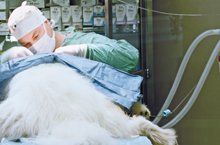Veterinary Medicine Essentials: Anesthesia
Each Veterinary Medicine Essentials package covers diagnostic steps, treatment plan guidance and the latest updates, plus resources to share with your entire veterinary team and your clients.

Anesthesia can be a scary prospect for human patients in hospitals and pet owners in the veterinary clinic. The apprehension that a beloved pet will never wake up puts the client, veterinarian, the dedicated veterinary anesthesia technician and the rest of the surgical team in the middle of a worrisome proposition. But you've got this covered, especially with the comprehensive look at all angles of veterinary anesthesia in today's hospital. This page not enough? You can get the latest on anesthesia (and our entire library on the subject) with a click right here.
Best anesthesia practices and techniques

Top strategies for high-risk anesthesia patients
Jul 12, 2016
"The breathing patient is a happy patient." ...
Just Ask the Expert: Light anesthesia anxiety
Jun 23, 2016
There are lessons for all veterinary practices in deciphering the cause of inadequate anesthetic depth in routine procedures. Here is a step-wise guide on what to consider as you perform your root-cause analysis. ...
3 wonderful trends in veterinary anesthesia
May 26, 2016
An anesthesiologist shares his excitement about trends in anesthesia, sedation and calming medications for cats and dogs. ...
Anesthesia reboot: Erase these myths and misconceptions
Aug 24, 2014
Veterinary anesthesiologist Dr. Ann Weil provides five important pointers on anesthetizing cats and dogs. ...
Local and regional anesthesia techniques, Part 1: Overview and five simple techniques
Jan 01, 2009
Add these 5 techniques to your clinical toolbox to help lessen your patients' pain. ...
Local and regional anesthesia techniques, Part 2: Stifle, intercostal, intrapleural, and forelimb techniques
Mar 01, 2009
These anesthetic methods, including one recently recommended alternative block, will help you control pain in animals undergoing stifle surgeries, forelimb surgeries, limb amputations, or thoracotomies, as well as in patients with thoracic trauma or cranial abdominal pain. ...
Local and regional anesthesia techniques, Part 3: Blocking the maxillary and mandibular nerves
Jun 01, 2009
This article discusses techniques associated with oral surgery. ...
Local and regional anesthesia techniques, Part 4: Epidural anesthesia and analgesia
Oct 01, 2009
Preoperative epidural injection of local anesthetics and opioids provides excellent preemptive, multimodal intraoperative analgesia; reduces the concentration of volatile anesthetic required to maintain surgical anesthesia; and provides analgesia extending into the recovery period. ...
Avoiding anesthetic complications and adverse effects

Journal Scan: Give vomit the ol' heave-ho in cats receiving anesthetics and pain medications
A recent study on the effects of maropitant in cats suggests it could help prevent vomiting when taken before dexmedetomidine and morphine, with one major caveat. ...
4 ways to avoid anesthesia complications
You can reduce your patients' potential for problems by staying clear of these common pitfalls. ...
4 anesthesia mistakes you might not know you're making
Anesthesia is a vital inclusion in any clinic's medical practice, but it does come with risks. By avoiding these common mistakes, your patients will receive a safer anesthetic experience. ...
Anesthesia-related hypotension in a small-animal practice
Hypotension, usually defined as mean arterial blood pressure less than 60 mm Hg or systolic arterial blood pressure less than 90 mm Hg, is reportedly one of the most common complications associated with general anesthesia in dogs and cats. ...
Anesthesia monitoring and postoperative recovery

Lecture Link: Postanesthesia monitoring pointers for small animals
Life-saving measures indeed since more than 50% of the complications with anesthesia occur while the patient is recovering. ...
Just Ask the Expert: Anesthesia monitoring and postoperative recovery checklist
Dr. Jenifer Newton shares her checklist-download it here. ...
Arterial blood gas analysis and interpretation in anesthetized patients
An introduction to the principles of clinical blood gas analysis and interpretation--including two case examples. ...
Anesthesia: Keeping close watch on blood pressure, ventilation vital during surgery
In 1915, Sir Frederick Hobday, a British veterinary surgeon, noted that "it is of no avail to have done any operation, however clever, if the patient succumbs to the anesthetic." ...
Anesthesia in dental procedures

Do you really need your best anesthesia equipment for dental patients?
You're about to anesthetize a 12-year-old Yorkie with blood pressure issues. 'Nuff said. ...
Questions from the dental trenches: Anesthesia and extractions
Get answers to your most commonly asked questions about two essential components of dental care in veterinary patients. ...
Skills Laboratory: How to perform four oral regional nerve blocks in dogs and cats
Try these quick and easy pain management techniques for oral surgery. ...
Caring for your anesthetic unit and veterinary dental monitoring equipment
Tips and tricks to ensure you don't ruin this essential, expensive equipment. ...
Monitoring anesthetized dental patients: the five-parameter approach
Clients frequently express concern about the anesthesia their dogs or cats need for professional oral evaluation and care. ...
Easing client fears of anesthesia

Get your veterinary dental clients to testify!
Clients afraid of the anesthesia necessary for dental care in their senior pets? Listen to this. ...
Knock out pet owners' anesthetic worries
Learn to talk to pet owners about the benefits and risks of anesthesia. ...
Attack veterinary clients' anesthesia fears
When clients hesitate to have their pet put under, be primed to pounce on their misconceptions, bat down myths about anesthesia, and strike back with facts and recommendations customized to their pet's condition. ...
Ease your veterinary clients' anesthesia fears
My clients are afraid of anesthesia. How can I explain the risks and importance? ...
5 common myths about veterinary anesthesia risks
Help clients understand exactly what's involved before their pet undergoes a surgical or dental procedure. ...
Arming your team

Anesthesia: The dead space hack
In tiny patients you might be concerned about extra dead space. Tasha McNerney, BS, CVT, CVPP, shares her favorite anesthesia tip she learned from Andrea M. Caniglia, VMD, DACVAA. ...
4 tough anesthesia and pain talks
Use this quick guide to answer common pet owner questions about their pets' pain management. ...
Important anesthesia monitoring tip for veterinary technicians
Technicians should be present in the moment and utilize all of their senses when monitoring a patient under anesthesia. ...
Anesthetic monitoring savvy
Understanding and interpreting data from a multi-parameter monitor is paramount to a successful anesthetic experience in veterinary practice. Consider this advice to understand these vital values and explore what to do when you encounter abnormalities. ...
Successful anesthesia takes the whole team
All veterinary team members play a role in providing patients safe anethetic experiences. ...
Podcast CE: A Surgeon’s Perspective on Current Trends for the Management of Osteoarthritis, Part 1
May 17th 2024David L. Dycus, DVM, MS, CCRP, DACVS joins Adam Christman, DVM, MBA, to discuss a proactive approach to the diagnosis of osteoarthritis and the best tools for general practice.
Listen